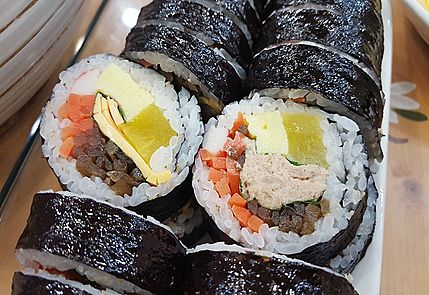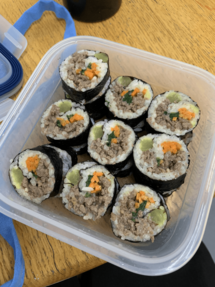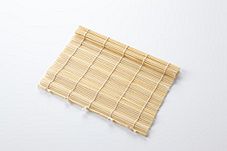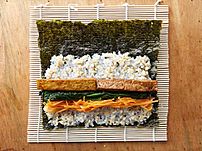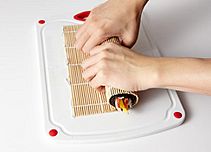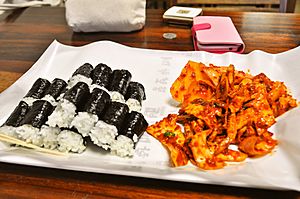Gimbap facts for kids
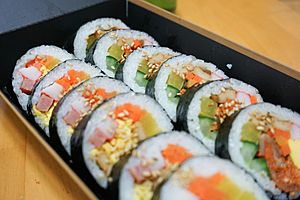
Sliced vegetable gimbap
|
|
| Place of origin | Korea |
|---|---|
| Main ingredients | Gim, bap |
| Variations | Chungmu-gimbap, samgak-gimbap |
| Korean name | |
| Hangul |
김밥
|
|---|---|
| Revised Romanization | gimbap |
| McCune–Reischauer | kimbap |
| IPA | [kim.bap̚]~[kim.p͈ap̚] |
Gimbap (김밥), also called kimbap, is a yummy Korean food. It is made from cooked rice and other tasty ingredients. These ingredients can be vegetables, fish, or meats. Everything is rolled up tightly in gim, which are dried sheets of seaweed.
Gimbap is cut into small, bite-sized pieces. People often pack it for picnics or outdoor events. It is a great light lunch, often eaten with yellow pickled radish (called danmuji) and kimchi. Gimbap is very popular in South Korea and other countries because it is easy to carry and eat on the go.
Contents
What Does "Gimbap" Mean?
The word gimbap comes from two Korean words. Gim (김) means edible seaweed. Bap (밥) means cooked rice. So, gimbap simply means "seaweed rice."
This name is quite new. A similar dish from the Joseon era (1392–1897) was called bokssam. The word gimbap started being used in a Korean newspaper in 1935. At that time, people also used the Japanese word norimaki. This word came into Korean during the time Japan ruled Korea (1910–1945). Later, gimbap became the main word. This was part of an effort to use more Korean words and fewer Japanese ones.
The History of Gimbap
No one is completely sure where gimbap came from. Some people think it came from a Japanese dish called makizushi. This idea suggests it was brought to Korea when Japan ruled the country. During that time, Koreans started to try some Japanese foods, like sushi rolls. However, gimbap soon became its own unique Korean dish. It uses traditional Korean flavors, like sesame oil, instead of rice vinegar.
Another idea is that gimbap grew from an old Korean tradition. For a long time, Koreans have rolled bap (cooked rice) and banchan (side dishes) in gim. Seaweed (gim) has been made in Korea since the 1400s. An old book from 1819 even talks about rice and fillings rolled in gim, calling it bokssam.
Today, gimbap and makizushi are different dishes. Gimbap usually has many ingredients inside and is seasoned with sesame oil. Makizushi often has just one ingredient, like cucumber or raw tuna, and uses rice vinegar.
How Gimbap is Made
The two main parts of gimbap are gim (seaweed) and bap (rice). Most often, people use short-grain white rice. But you can also use brown rice or other grains.
Popular Gimbap Fillings
Gimbap can have many different fillings. Some popular ones are:
- Yellow pickled radish (danmuji)
- Ham or beef
- Fake crab meat
- Egg strips
- Kimchi
- Bulgogi (marinated beef)
- Spinach and carrot
- Burdock root
- Cucumber
- Canned tuna
- Kkaennip (perilla leaves)
Some special kinds of gimbap might even have cheese, spicy squid, luncheon meat, or spicy tuna. The seaweed can be brushed with sesame oil or sprinkled with sesame seeds. Sometimes, sliced gimbap pieces are lightly fried with an egg coating.
Rolling Gimbap
Making gimbap is a fun process:
- First, the gim sheets are lightly toasted.
- The cooked rice is mixed with a little salt and sesame oil.
- The vegetables and meats are seasoned and cooked.
- Then, a toasted gim sheet is placed on a gimbal. A gimbal is a special bamboo mat used for rolling.
- A thin layer of rice is spread evenly on the gim.
- The other ingredients are placed on top of the rice.
- Finally, everything is carefully rolled into a cylinder shape. It's usually about 3 to 4 centimeters wide.
- The rolled gimbap is then sliced into small, bite-sized pieces.
Different Kinds of Gimbap
There are many fun variations of gimbap:
- Chungmu-gimbap (충무김밥) — This kind comes from a seaside city. The rolls are thinner and only have rice inside. They are served with spicy squid salad and radish kimchi.
- Mayak-gimbap (마약김밥) — This is a special gimbap from Gwangjang Market in Seoul. It has small rolls filled with carrots, spinach, and yellow pickled radish. It's sprinkled with sesame seeds and dipped in a soy sauce and mustard dip.
- Samgak-gimbap (삼각김밥) — This means "triangle gimbap." It looks like Japanese onigiri and is sold in convenience stores in South Korea. The fillings are very different, and it's a quick, easy snack.
- Nude gimbap (누드김밥) — In this type, the rice is on the outside, and the ingredients are on the inside. It's a bit like a California roll sushi, but it uses Korean ingredients like ham, meat, pickled radish, and spinach. It's often served with cheese or sauce.
- Yukhoe gimbap (육회김밥) — This gimbap is similar to Japanese raw fish rolls. But it uses yukhoe, which is a Korean raw meat dish, along with pickled radish, perilla leaves, and scallions.
Gimbap Restaurants
Many fast food restaurants in South Korea specialize in gimbap and noodles. Some popular chains include Gimbap Cheonguk, Kobongmin Gimbabin, Teacher Kim, Gimbap Nara, and Charles Sutbul Gimbap.
See also
 In Spanish: Gimbap para niños
In Spanish: Gimbap para niños


